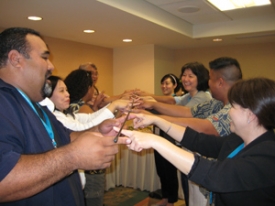Capacity Building
 APPEAL has defined community capacity as a community’s current ability (as opposed to inherent ability) to respond to certain pressures. When looking at the impact of tobacco on communities, one must look not only on tobacco use rates and patterns, but also on the ability of a community to respond to tobacco control comprehensively.
APPEAL has defined community capacity as a community’s current ability (as opposed to inherent ability) to respond to certain pressures. When looking at the impact of tobacco on communities, one must look not only on tobacco use rates and patterns, but also on the ability of a community to respond to tobacco control comprehensively.
In 1996, under the leadership of Dr. Robert Robinson of Centers for Disease Control and Prevention’s Office on Smoking and Health, a community’s capacity to address tobacco was examined for four major ethnic groups. Among these groups, Asian American and Pacific Islanders were found to have had a low to very low capacity to conduct research, develop an infrastructure, create and manage programs, and develop policy initiatives on tobacco control.1
Recognizing the on-going need for this sort of examination, APPEAL has developed a Stages of Readiness model based on Prochaska’s Stages of Change model.2 The Stages of Readiness model can be used to assist communities in identifying their various capacities to respond to tobacco. Once this is done, these communities will then be able to focus their efforts on capacity building activities such as infrastructure, program and policy development, as well as leadership training.
Programs:
1 Robinson, R.G., Shelton, D.M., Hodge, F., Lew, R., Lopex, E., Toy, P., Merritt, R. & Yach, D., 1995. “Tobacco control capacity index for communities of color in the United States.” In Tobacco and Health, ed. Karen Slama, 359-365. New York: Plenum Press
2 Prochaska, J.O., DiClemente, C.C. Stages and process of self-change in smoking: Toward an integrative model of change. Journal of Consulting and Clinical Psychology 1983:390-395
